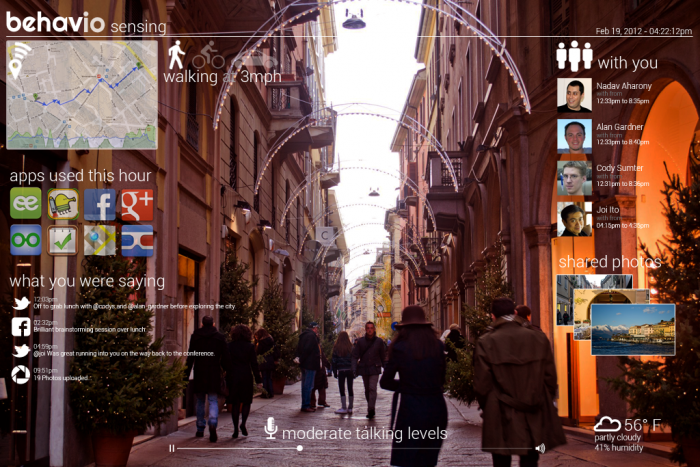

“When you leave the house, the three things you usually take with you are your keys, your wallet, and your phone,” says Nadav Aharony. One of those three things is a “sensing and processing machine,” he says. (Hint: not your keys.) The smartphone in your pocket knows where you are, who you’re with, how fast you’re moving, whether you’re standing up or sitting down.
What if we could refine all of this invisible metadata into meaningful stories?
Aharony and his colleagues, Cody Sumter and Alan Gardner — all recent or soon-to-be recent MIT Media Lab grads — are building an open-source platform that simplifies this kind of mobile data collection. They want to enable a new generation of apps that can detect social and behavioral trends in communities.
Now, with a $355,000 Knight News Challenge grant, the trio will turn this three-year side project into a full-time concern called Behavio. The guys are all quitting their jobs or giving up job offers to do this. Their next job is to figure out how this software could work for journalists.
Smartphone data can predict flu outbreaks even before subjects report symptoms.
Our devices could power early-warning systems for disease outbreaks or provide life-saving data during disasters. Think of it as “trending topics for a community,” Sumter told me. For example, “an apartment complex full of people stopped showing up to work…If you had some third-party news sources, people were able to donate their own data, this would have sent up a massive red flag.”
Although smartphones are equipped with dozens of sensors — for light, sound, gravity, motion, proximity, pressure, even magnetic fields — “it’s very hard today to tap into these capabilities,” Aharony said. “When the big organizations do this, it’s usually closed-source…so small developers end up doing everything from scratch.” Storing data securely, sending it to a server, and optimizing for battery life are big technical challenges.
Funf (“fun framework”) is the framework the team created to solve these problems for developers. If you have zero programming experience but want to play, they created Funf in a Box, a wizard that lets you pick from all kinds of options and then deposits a fully baked sample app into your Dropbox account. (Funf only works with Android devices right now, as Google’s devices are much more accommodating to tinkerers than Apple’s.)
The team mocked up a sample interface that superimposes “smart” metadata on a photo. You can see the user was walking at three miles per hour, he was outside, he had been walking for about a mile yet, he was with three friends, it was 56 degrees and partly cloudy, and the ambient noise level was moderate.

Alex “Sandy” Pentland, the director of MIT’s Human Dynamics Group and Aharony’s adviser, has been doing this kind of work with controlled groups for a few years. Pentland has tracked the spread of political opinions, fads, and influenza through communities. Pentland was able to predict which subjects were coming down with the flu before they reported any symptoms (PDF). A few days before participants reported having sore throats — before they felt sick — motion sensors captured less activity during the day. Participants who reported fever sent fewer late-night texts and had fewer face-to-face interactions, as determined by Bluetooth sensors picking up other Bluetooth sensors nearby.
These changes in behavior are virtually undetectable to us, but computers are good at detecting deviations from routine. The always-on devices in our pockets can silently capture it all.
This new breed of apps raises all kinds of privacy concerns, of course. But “in open-source, you can actually show what you’re collecting,” Aharony said. They hope to avoid privacy scares, such as we’ve seen from the likes of Apple and Path, through open source’s transparency.
“We are embedding privacy detection. The framework doesn’t save any data,” he said. Say a developer writes an app that captures which phone numbers a person dials most frequently. Each number is hashed with a one-way encoding algorithm. So (617) 555-1234 is stored as 85010bb1da7782773ca7ea24f976ab67. A software program can see that an identical string appears frequently, but a human can’t extract any meaning from it.
Behavio fits with the Knight Foundation’s theme for this iteration of News Challenge, networks. The new, nimbler News Challenge is more pragmatic, preferring people who are builders more than dreamers. Aharony, Sumter, and Gardner have a head start, with working code and about 500 developers already using the framework.
Gardner said Behavio will focus on building the framework more than individual apps. “We’re sort of enabling this ecosystem,” he said. “We want a kid in college to build an app in a year he’d never be able to build on his own.”